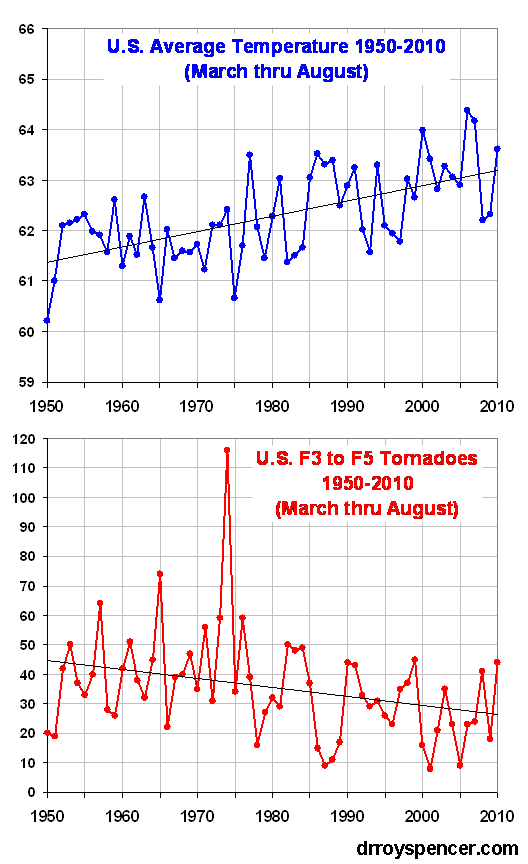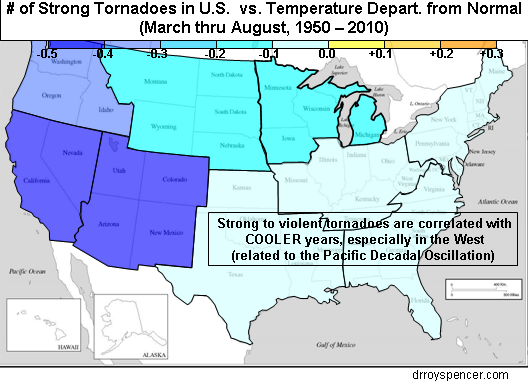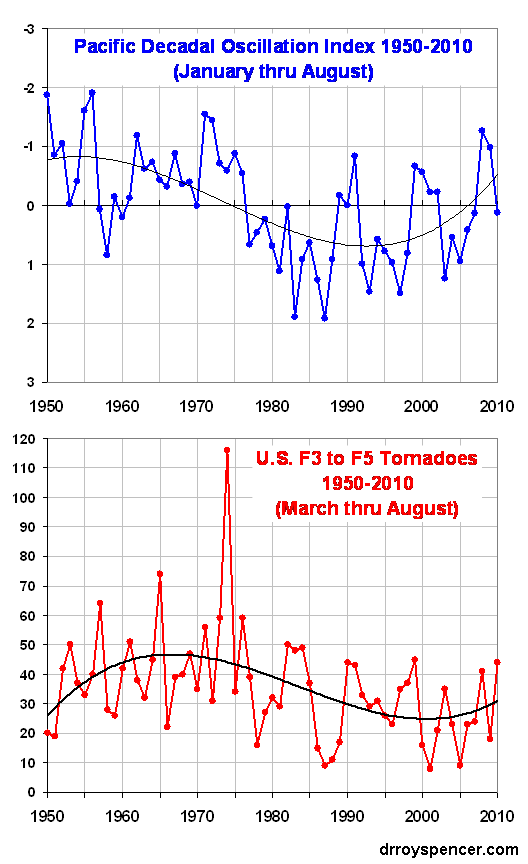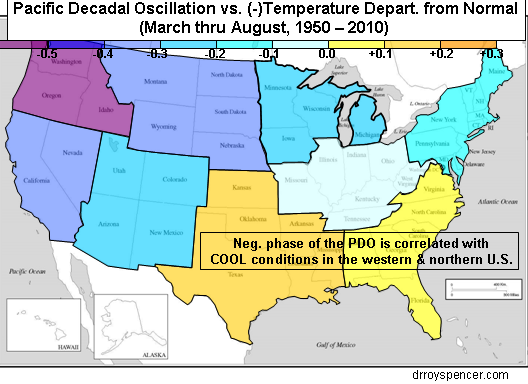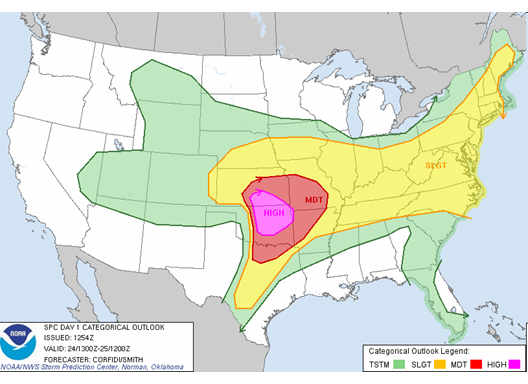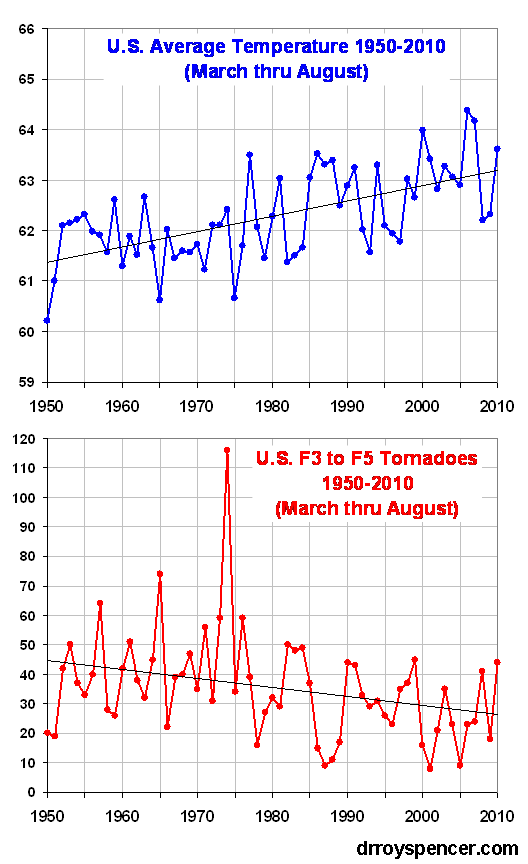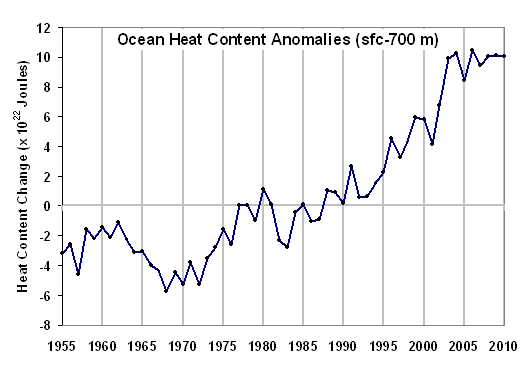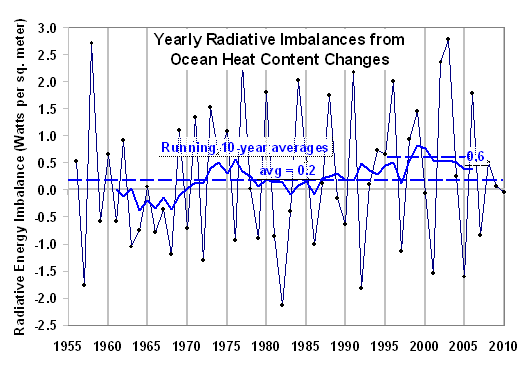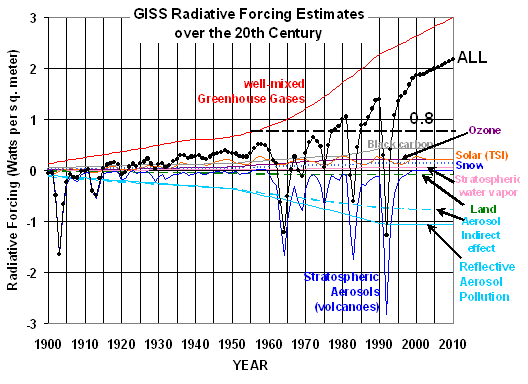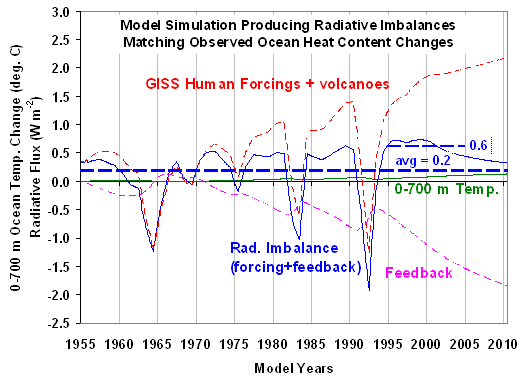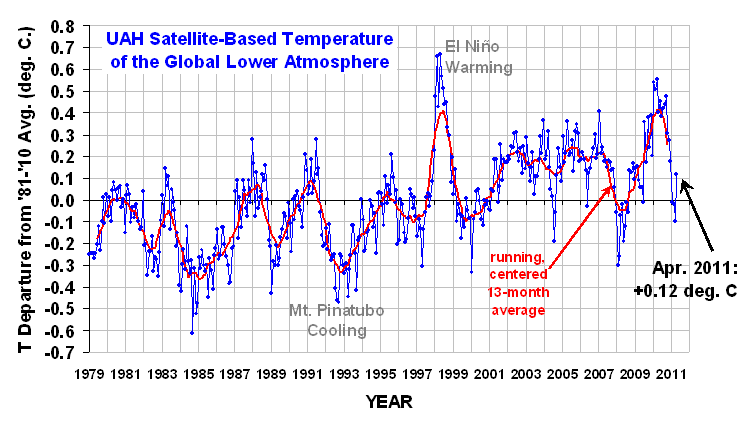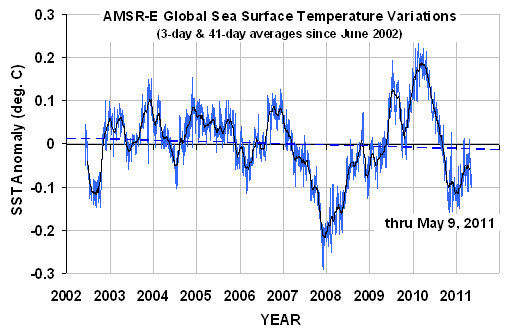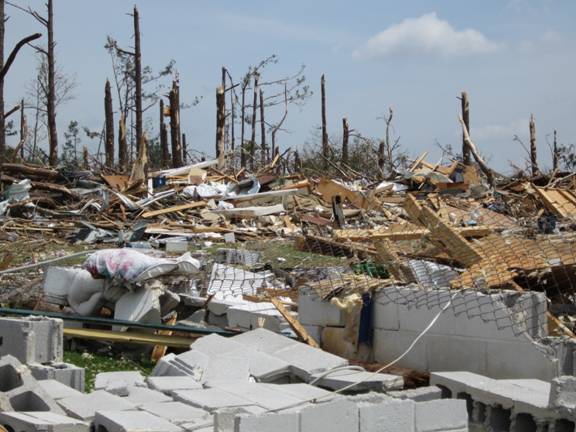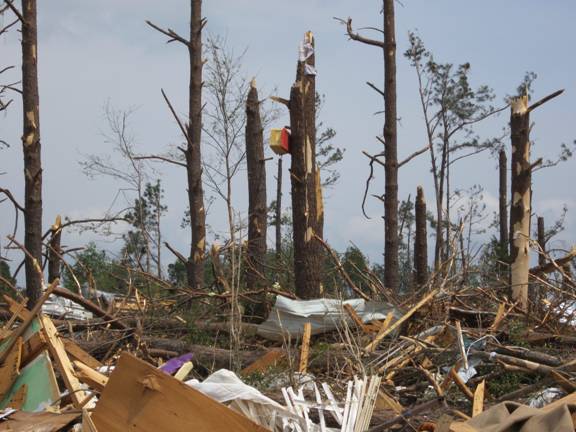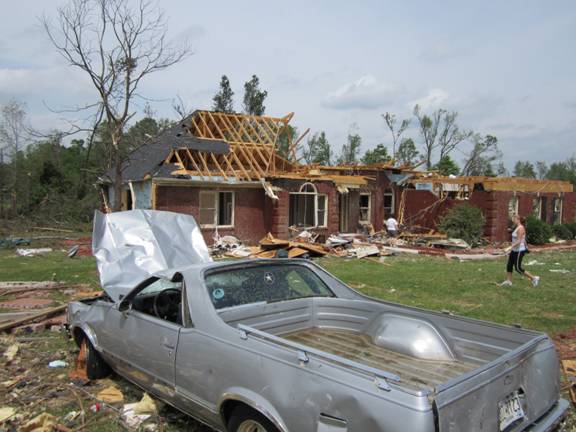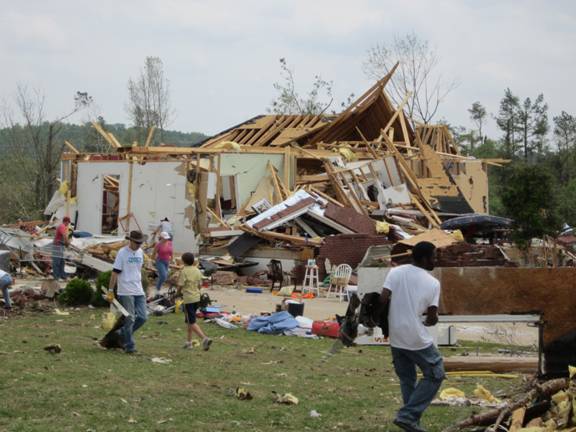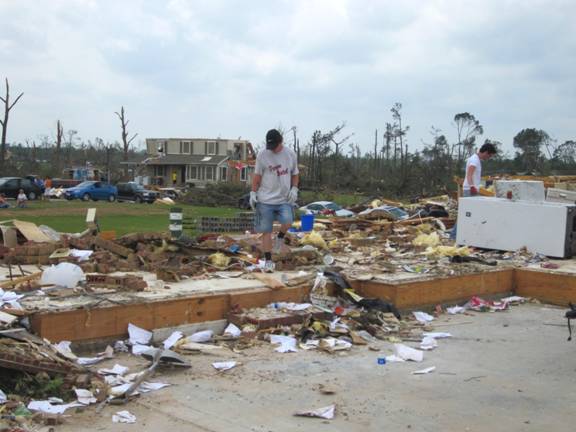UPDATE (12:35 p.m. CDT 19 May 2011): revised corrections of CERES data for El Nino/La Nina effects.
While I have been skeptical of Svensmark’s cosmic ray theory up until now, it looks like the evidence is becoming too strong for me to ignore. The following results will surely be controversial, and the reader should remember that what follows is not peer reviewed, and is only a preliminary estimate.
I’ve made calculations based upon satellite observations of how the global radiative energy balance has varied over the last 10 years (between Solar Max and Solar Min) as a result of variations in cosmic ray activity. The results suggest that the total (direct + indirect) solar forcing is at least 3.5 times stronger than that due to changing solar irradiance alone.
If this is anywhere close to being correct, it supports the claim that the sun has a much larger potential role (and therefore humans a smaller role) in climate change than what the “scientific consensus” states.
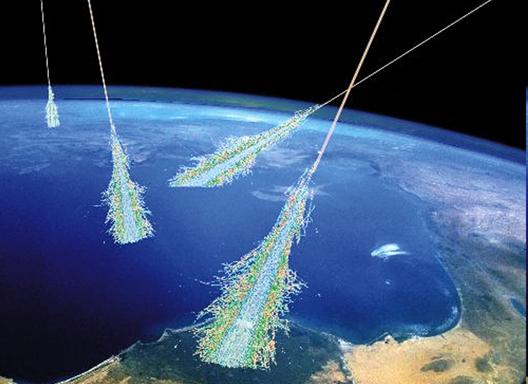
BACKGROUND
The single most frequently asked question I get after I give my talks is, “Why didn’t you mention the sun?” I usually answer that I’m skeptical of the “cosmic ray gun” theory of cloud changes controlling climate. But I point out that Svensmark’s theory of natural cloud variations causing climate change is actually pretty close to what I preach — only the mechanism causing the cloud change is different.
Then, I found last year’s paper by Laken et al. which was especially interesting since it showed satellite-observed cloud changes following changes in cosmic ray activity. Even though the ISCCP satellite data they used are not exactly state of the art, the study was limited to the mid-latitudes, and the time scales involved were days rather than years, the results gave compelling quantitative evidence of a cosmic ray effect on cloud cover.
With the rapid-fire stream of publications and reports now coming out on the subject, I decided to go back and spend some time analyzing ground-based galactic cosmic ray (GCR) data to see whether there is a connection between GCR variations and variations in the global radiative energy balance between absorbed sunlight and emitted infrared energy, taken from the NASA CERES radiative budget instruments on the Terra satellite, available since March 2000.
After all, that is ultimately what we are interested in: How do various forcings affect the radiative energy budget of the Earth? The results, I must admit, are enough for me to now place at least one foot solidly in the cosmic ray theory camp.
THE DATA
The nice thing about using CERES Earth radiative budget data is that we can get a quantitative estimate in Watts per sq. meter for the radiative forcing due to cosmic ray changes. This is the language the climate modelers speak, since these radiative forcings (externally imposed global energy imbalances) can be used to help calculate global temperature changes in the ocean & atmosphere based upon simple energy conservation. They can then also be compared to the estimates of forcing from increasing carbon dioxide, currently the most fashionable cause of climate change.
From the global radiative budget measurements we also get to see if there is a change in high clouds (inferred from the outgoing infrared measurements) as well as low clouds (inferred from reflected shortwave [visible sunlight] measurements) associated with cosmic ray activity.
I will use only the ground-based cosmic ray data from Moscow, since it is the first station I found which includes a complete monthly archive for the same period we have global radiative energy budget data from CERES (March 2000 through June 2010). I’m sure there are other stations, too…all of this is preliminary anyway. Me sifting through the myriad solar-terrestrial datasets is just as confusing to me as most of you sifting through the various climate datasets that I’m reasonably comfortable with.
THE RESULTS
The following plot (black curve) shows the monthly GCR data from Moscow for this period, as well as a detrended version with 1-2-1 averaging (red curve) to match the smoothing I will use in the CERES measurements to reduce noise.
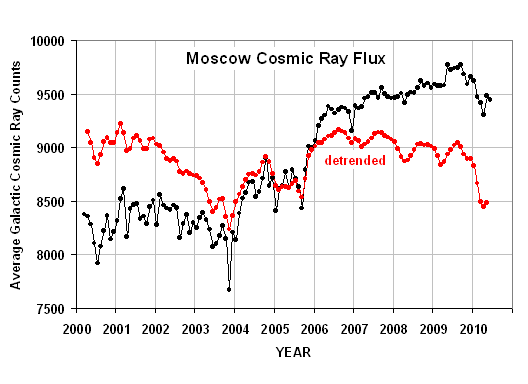
Detrending the data isolates the month-to-month and year-to-year variability as the signal to match, since trends (or a lack of trends) in the global radiative budget data can be caused by a combination of many things. (Linear trends are worthless for statistically inferring cause-and-effect; but getting a match between wiggles in two datasets is much less likely to be due to random chance.)
The monthly cosmic ray data at Moscow will be compared to global monthly anomalies the NASA Terra satellite CERES (SSF 2.5 dataset) radiative flux data,
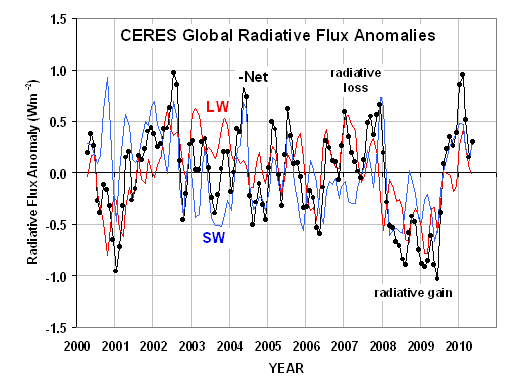
which shows the variations in global average reflected sunlight (SW), emitted infrared (LW), and Net (which is the estimated imbalances in total absorbed energy by the climate system, after adjustment for variations in total solar irradiance, TSI). Note I have plotted the variations in the negative of Net, which is approximately equal to variations in (LW+SW)
Then, since the primary source of variability in the CERES data is associated with El Nino and La Nina (ENSO) activity, I subtracted out an estimate of the average ENSO influence using running regressions between running 5-month averages of the Multivariate ENSO Index (MEI) and the CERES fluxes. I used the MEI index along with those regression coefficients in each month to correct the CERES fluxes 4 months later, since that time lag had the strongest correlation.
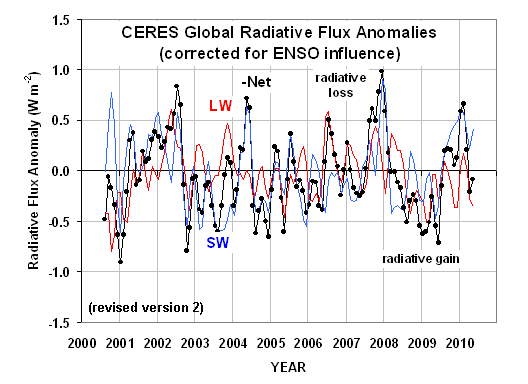
Finally, I performed regressions at various leads and lags between the GCR time series and the LW, SW, and -Net radiative flux time series, the results of which are shown next.
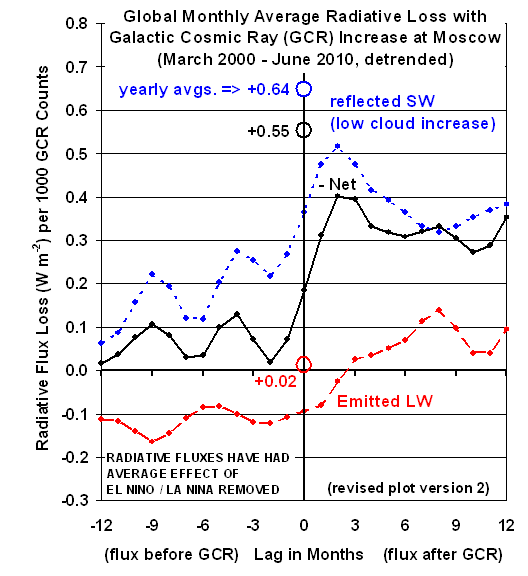
The yearly average relationships noted in the previous plot come from this relationship in the reflected solar (SW) data,
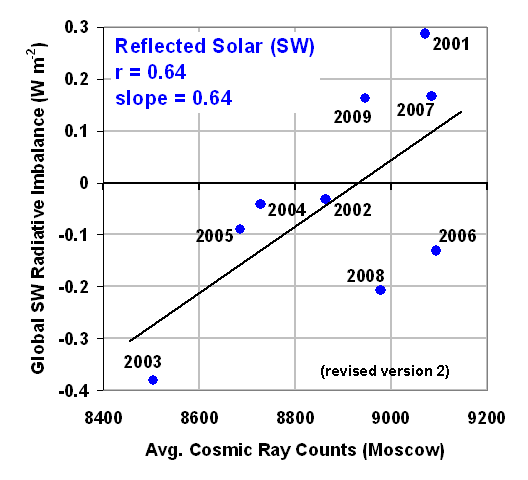
while the -Net flux (Net is absorbed solar minus emitted infrared, corrected for the change in solar irradiance during the period) results look like this:
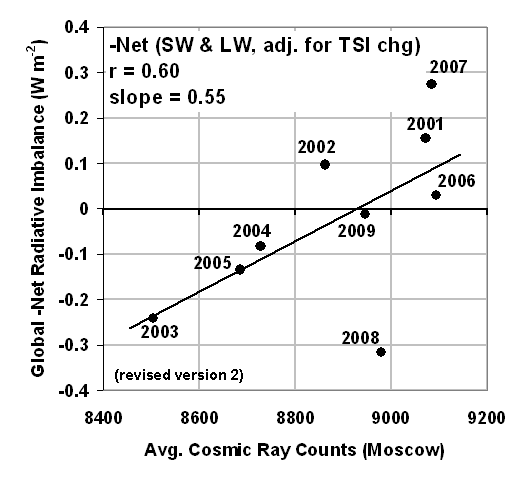
It is that last plot that gives us the final estimate of how a change in cosmic ray flux at Moscow is related to changes in Earth’s radiative energy balance.
SUMMARY
What the above three plots show is that for a 1,000 count increase in GCR activity as measured at Moscow (which is somewhat less than the increase between Solar Max and Solar Min), there appears to be:
(1) an increase in reflected sunlight (SW) of 0.64 Watts per sq. meter, probably mostly due to an increase in low cloud cover;
(2) virtually no change in emitted infrared (LW) of +0.02 Watts per sq. meter;
(3) a Net (reflected sunlight plus emitted infrared) effect of 0.55 Watts per sq. meter loss in radiant energy by the global climate system.
WHAT DOES THIS MEAN FOR CLIMATE CHANGE?
Assuming these signatures are anywhere close to being real, what do they mean quantitatively in terms of the potential effect of cosmic ray activity on climate?
Well, just like any other forcing, a resulting temperature change depends not only upon the size of the forcing, but also the sensitivity of the climate system to forcing. But we CAN compare the cosmic ray forcing to OTHER “known” forcings, which could have a huge influence on our understanding of the role of humans in climate change.
For example, if warming observed in the last century is (say) 50% natural and 50% anthropogenic, then this implies the climate system is only one-half as sensitive to our greenhouse gas emissions (or aerosol pollution) than if the warming was 100% anthropogenic in origin (which is pretty close to what we are told the supposed “scientific consensus” is).
First, let’s compare the cosmic ray forcing to the change in total solar irradiance (TSI) during 2000-2010. The orange curve in following plot is the change in direct solar (TSI) forcing between 2000 and 2010, which with the help of Danny Braswell’s analytical skills I backed out from the CERES Net, LW, and SW data. It is the only kind of solar forcing the IPCC (apparently) believes exists, and it is quite weak:
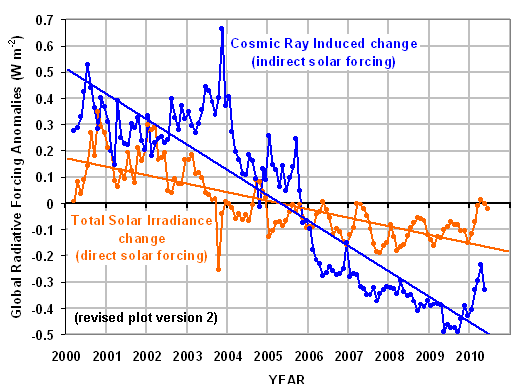
Also shown is the estimated cosmic ray forcing resulting from the month-to-month changes in the original Moscow cosmic ray time series, computed by multiplying those monthly changes by 0.55 Watts per sq. meter per 1,000 cosmic ray counts change.
Finally, I fitted the trend lines to get an estimate of the relative magnitudes of these two sources of forcing: the cosmic ray (indirect) forcing is about 2.8 times that of the solar irradiance (direct) forcing. This means the total (direct + indirect) solar forcing on climate associated with the solar cycle could be 3.8 times that most mainstream climate scientists believe.
One obvious question this begs is whether the lack of recent warming, since about 2004 for the 0-700 meter layer of the ocean, is due to the cosmic ray effect on cloud cover canceling out the warming from increasing carbon dioxide.
If the situation really was that simple (which I doubt it is), this would mean that with Solar Max rapidly approaching, warming should resume in the coming months. Of course, other natural cycles could be in play (my favorite is the Pacific Decadal oscillation), so predicting what will happen next is (in my view) more of an exercise in faith than in science.
In the bigger picture, this is just one more piece of evidence that the IPCC scientists should be investigating, one which suggests a much larger role for Mother Nature in climate change than the IPCC has been willing to admit. And, again I emphasize, the greater the role of Nature in causing past climate change, the smaller the role humans must have had, which could then have a profound impact on future projections of human-caused global warming.

 Home/Blog
Home/Blog